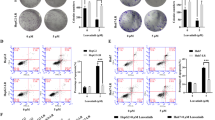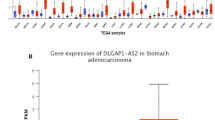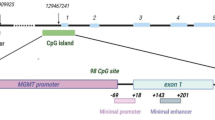Abstract
Poor treatment results in advanced hepatoblastoma (HB) made alternative treatment approaches desirable. Gene-directed tumor therapy is increasingly investigated in different malignancies. The aim of this study was to analyze possible alternatives of gene transfer into HB cells and to study therapeutic applications based on different strategies. Liposomal transfection of HB cells was assessed using liver-specific promoters, and adenovirus and Sendai virus transductions were performed in vitro. Transfer efficiencies were measured via flow cytometry determining expression of vector-encoded marker gene green fluorescent protein. Gene silencing of the anti-apoptotic bcl-2 gene in HUH6 cells was performed using lipofection of small interfering RNA (siRNA). Additionally, suicide gene therapy was carried out through a yeast-derived cytosine deaminase (YCD)-combined yeast uracil phosphoribosyltransferase (YUPRT)-based adenovirus-mediated gene transfer, leading to a potent intracellular prodrug transformation of 5-fluorocytosine into 5-fluorouracil. Treatment efficiencies were monitored via MTT viability assay. Highest gene transfer rates (86%) were observed using adenovirus transduction. We furthermore observed a significant therapeutic effect of adenovirus-mediated YCD::YUPRT suicide gene transfer. Liposomal-mediated anti-bcl-2 siRNA transfer led to a significant improvement of cisplatin treatment in HUH6 cells. Liver-specific promoters were found to be strongly active in HUH6 cells (mixed HB-derived), but less active in HepT1 cells (embryonal HB-derived). Liposomal transfection and viral transduction are effective approaches to genetically manipulate HB cells in vitro. For the first time, we demonstrate a positive effect of siRNA gene silencing in this malignancy. Additionally, we successfully investigated a model of adenovirus-based suicide gene therapy in HB cell cultures. Our data strongly encourage further studies assessing these alternative treatment approaches.




Similar content being viewed by others
References
Fuchs J, Rydzynski J, von Schweinitz D et al (2002) Pretreatment prognostic factors and treatment results in children with hepatoblastoma—a report from the German Cooperative Pediatric Liver Tumor Study HB 94. Cancer 95:172–182
Brown J, Perilongo G, Shafford E et al (2000) Pretreatment prognostic factors for children with hepatoblastoma—results from the International Society of Paediatric Oncology (SIOP) study SIOPEL 1. Eur J Cancer 36:1418–1425
Warmann S, Hunger M, Teichmann B et al (2002) The role of the MDR1 gene in the development of multidrug resistance in human hepatoblastoma—clinical course and in vivo model. Cancer 95:1795–1801
Von Schweinitz D, Hecker H, Harms D et al (1995) Complete resection before development of drug resistance is essential for survival from advanced hepatoblastoma. J Pediatr Surg 30:845–852
Warmann SW, Fuchs J, Seitz G, Ruck P, Treuner C, Mahrt J, Muller GA, Wessels JT (2005) New trends in tumor biology: transfection of a human hepatoblastoma cell line with green fluorescent protein. J Pediatr Surg 40:653–657
Konishi M, Wu CH, Wu GY (2003) Inhibition of HBV replication by siRNA in a stable HBV-producing cell line. Hepatology 38:842–850
Mullen JT, Tanabe KK (2003) New approaches to the treatment of hepatic malignancies—viral oncolysis for malignant liver tumors. Ann Surg Oncol 10:569–605
Bitzer M, Armeanu S, Lauer UM, Neubert WJ (2003) Sendai virus vectors as an emerging negative-strand RNA viral vector system. J Gene Med 5:543–553
Pietsch T, Fonatsch C, Albrecht S, Maschek H, Wolf HK, von Schweinitz D (1996) Characterization of the continuous cell line HepT1 derived from a human hepatoblastoma. Lab Invest 74:809–818
Doi I (1976) Establishment of a cell line and its clonal sublines from a patient with hepatoblastoma. Gann 67:1–10
Lemken ML, Wybranietz WA, Schmidt U, Graepler F, Armeanu S, Bitzer M, Lauer UM (2005) Liver-directed gene expression employing synthetic transcriptional control units. World J Gastroenterol 11:5295–5302
Ramaswamy G, Slack FJ (2002) siRNA. A guide for RNA silencing. Chem Biol 9:1053–1055
Mosmann T (1983) Rapid colorimetric assay for cellular growth and survival: application to proliferation and cytotoxicity assays. J Immunol Methods 65:55–63
Wybranietz W, Gross C, Phelan A et al (2001) Enhanced suicide gene effect by adenoviral transduction of a VP22-cytosine deaminase (CD) fusion gene. Gene Ther 8:1654–1664
Leyrer S, Neubert WJ, Sedlmeier R (1998) Rapid and efficient recovery of Sendai virus from cDNA: factors influencing recombinant virus rescue. J Virol Methods 75:47–58
Bitzer M, Prinz F, Bauer M et al (1999) Sendai virus infection induces apoptosis through activation of caspase-8 (FLICE) and caspase-3 (CPP32). J Virol 73:702–708
Chartier C, Degryse E, Gantzer M et al (1996) Efficient generation of recombinant adenovirus vectors by homologous recombination in Escherichia coli. J Virol 70:4805–4810
Chroboczek J, Bieber F, Jacrot B (1992) The sequence of the genome of adenovirus type 5 and its comparison with the genome of adenovirus type 2. Virology 186:280–285
Graepler F, Lemken ML, Wybranietz WA, Schmidt U, Smirnow I, Groß CD, Spiegel M, Schenk A, Graf H, Lauer UA, Vonthein R, Gregor M, Armeanu S, Bitzer M, Lauer UM (2005) Bifunctional chimeric SuperCD suicide gene (YCD::YUPRT fusion) is highly effective in a rat hepatoma model. World J Gastroenterol (in press)
Wilson JM (2001) Adenovirus-mediated gene transfer to liver. Adv Drug Deliv Rev 46:205–209
Conran RM, Hitchcock CL, Waclawiw MA, Stocker JT, Ishak KG (1992) Hepatoblastoma: the prognostic significance of histologic type. Pediatr Pathol 12:167–183
Warmann SW, Heitmenn H, Teichmann B et al (2005) Effects of P-glycoprotein modulation on the chemotherapy of xenotransplanted human hepatoblastoma. Pediatr Hematol Oncol 22:373–386
Bai J, Sui J, Demirjian A et al (2005) Predominant Bcl-XL knockdown disables antiapoptotic mechanisms: tumor necrosis factor-related apoptosis-inducing ligand-based triple chemotherapy overcomes chemoresistance in pancreatic cancer cells in vitro. Cancer Res 65:2344–2352
Wang L, Hernández-Alcoceba R, Shankar V et al (2004) Prolonged and inducible transgene expression in the liver using gutless adenovirus: a potential therapy for liver cancer. Gastroenterol 126:278–289
Adachi Y, Reynolds PN, Yamamoto M et al (2000) Midkine promoter-based adenoviral vector gene delivery for pediatric solid tumors. Cancer Res 60:4305–4310
Schmitz V, Wang L, Barajas M, Gomar C, Prieto J, Qian C (2004) Treatment of colorectal and hepatocellular carcinomas by adenoviral mediated gene transfer of endostatin and angiostatin-like molecule in mice. Gut 53:561–567
Aramaki Y, Lee I, Arima H et al (2003) Efficient gene transfer to hepatoblastoma cells through asialoglycoprotein receptor and expression under the control of the glycin A promoter. Biol Pharm Bull 26:357–360
Stoff-Khalili MA, Rivera AA, Glasgow JN et al (2005) A human adenoviral vector with a chimeric fiber from canine adenovirus type 1 results in novel expanded tropism for cancer gene therapy. Gene Ther 12:1696–1706
Perilongo G, Shafford E, Maibach R et al (2004) Risk-adapted treatment for childhood hepatoblastoma. Final report of the second study of the International Society of Paediatric Oncology—SIOPEL 2. Eur J Cancer 40:411–421
Fuchs J, Rydzynski J, von Schweinitz D et al (2002) Pretreatment prognostic factors and treatment results in children with hepatoblastoma—a report from the German Cooperative Pediatric Liver Tumor Study HB 94. Cancer 95:172–182
Warmann S, Göhring G, Teichmann B et al (2003) P-glycoprotein modulation improves in vitro chemosensitivity in malignant pediatric liver tumors. Anticancer Res 23:4607–4612
Vallerga AK, Zarling DA, Kinsella TJ (2004) New radiosensitizing regimens, drugs, prodrugs, and candidates. Clin Adv Hematol Oncol 2:793–805
Gray SG, Hartmann W, Eriksson T et al (2000) Expression of genes involved with cell cycle control, cell growth and chromatin modification are altered in hepatoblastomas. Int J Mol Med 6:161–169
Author information
Authors and Affiliations
Corresponding author
Additional information
Steven W. Warmann and Sorin Armeanu contributed equally to this work.
Rights and permissions
About this article
Cite this article
Warmann, S.W., Armeanu, S., Frank, H. et al. In vitro gene targeting in human Hepatoblastoma. Ped Surgery Int 22, 16–23 (2006). https://doi.org/10.1007/s00383-005-1573-8
Published:
Issue Date:
DOI: https://doi.org/10.1007/s00383-005-1573-8




